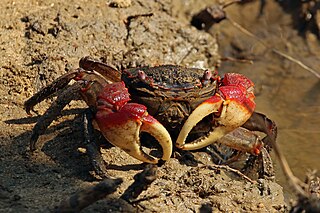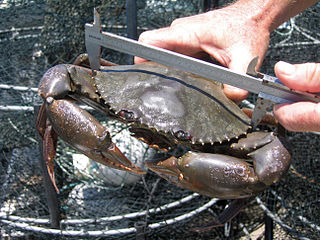
Leyte Gulf, also known simply as the Leyte, is a gulf in the Eastern Visayan region in the Philippines. The bay is part of the Philippine Sea of the Pacific Ocean, and is bounded by two islands; Samar in the north and Leyte in the west. On the south of the bay is Mindanao Island, separated from Leyte by the Surigao Strait. Dinagat Island partly encloses the gulf to the southeast, and the small Homonhon Island and Suluan Island, sit astride the eastern entrance to the Gulf. It is approximately 130 km (81 mi) north-south, and 60 km (37 mi) east-west.
Mud crab may refer to any crab that lives in or near mud, such as:

Mudflats or mud flats, also known as tidal flats or, in Ireland, slob or slobs, are coastal wetlands that form in intertidal areas where sediments have been deposited by tides or rivers. A global analysis published in 2019 suggested that tidal flat ecosystems are as extensive globally as mangroves, covering at least 127,921 km2 (49,391 sq mi) of the Earth's surface. They are found in sheltered areas such as bays, bayous, lagoons, and estuaries; they are also seen in freshwater lakes and salty lakes alike, wherein many rivers and creeks end. Mudflats may be viewed geologically as exposed layers of bay mud, resulting from deposition of estuarine silts, clays and aquatic animal detritus. Most of the sediment within a mudflat is within the intertidal zone, and thus the flat is submerged and exposed approximately twice daily.

Mangrove crabs are crabs that live in and around mangroves. They belong to many different species and families and have been shown to be ecologically significant by burying and consuming leaf litter. Mangrove crabs have a variety of phylogenies because mangrove crab is an umbrella term that encompasses many species of crabs. Two of the most common families are sesarmid and fiddler crabs. They are omnivorous and are predated on by a variety of mammals and fish. They are distributed widely throughout the globe on coasts where mangroves are located. Mangrove crabs have wide variety of ecological and biogeochemical impacts due to the biofilms that live in symbiosis with them as well as their burrowing habits. Like many other crustaceans, they are also a human food source and have been impacted by humans as well as climate change.

Scylla serrata is an ecologically important species of crab found in the estuaries and mangroves of Africa, Australia, and Asia. In their most common forms, their shell colours vary from a deep, mottled green to very dark brown.

Mangrove forests, also called mangrove swamps, mangrove thickets or mangals, are productive wetlands that occur in coastal intertidal zones. Mangrove forests grow mainly at tropical and subtropical latitudes because mangrove trees cannot withstand freezing temperatures. There are about 80 different species of mangroves, all of which grow in areas with low-oxygen soil, where slow-moving waters allow fine sediments to accumulate.

Scylla paramamosain is a mud crab commonly consumed in Southeast Asia.

Portunidae is a family of crabs which contains the swimming crabs. Its members include many well-known shoreline crabs, such as the blue crab and velvet crab. Two genera in the family are contrastingly named Scylla and Charybdis; the former contains the economically important species black crab and Scylla paramamosain.

Salim Ali Bird Sanctuary is an estuarine mangrove habitat, which is declared as the bird sanctuary, and located on western tip of the Island of Chorão along the Mandovi River, Goa, in India. The sanctuary is named after Salim Ali, the eminent Indian ornithologist.

The tall-stilt mangrove belongs to the Plantae kingdom under the Rhizophoraceae family. R. apiculata is distributed throughout Southeast Asia and the western Pacific islands.

Crab fisheries are fisheries which capture or farm crabs. True crabs make up 20% of all crustaceans caught and farmed worldwide, with about 1.4 million tonnes being consumed annually. The horse crab, Portunus trituberculatus, accounts for one quarter of that total. Other important species include flower crabs, snow crabs (Chionoecetes), blue crabs, edible or brown crabs, Dungeness crab, and mud crabs, each of which provides more than 20,000 tonnes annually.

Scylla is a genus of swimming crabs, comprising four species, of which S. serrata is the most widespread. They are found across the Indo-West Pacific. The four species are:

The Southern Africa mangroves are mangrove ecoregion on the Mozambique's southernmost coast and the eastern coast of South Africa.

Aratus pisonii, commonly known as the mangrove tree crab, is a species of crab which lives in mangrove trees in tropical and subtropical parts of the Americas, from Florida to Brazil on the Atlantic coast. A.pacificus occurs from Nicaragua to Peru on the Pacific coast. A. pisoni feeds mostly on the leaves of the mangroves, but is an omnivore, and prefers animal matter when possible. A. pisonii and A. pacificus are the two species in the genus Aratus. The specific epithet pisonii commemorates the Dutch naturalist Willem Piso who travelled in Brazil in 1638 with Georg Marggraf.

Australia has coastal areas where mangrove thickets and swamps occur, such as in the intertidal zones of protected tropical, subtropical and some temperate coastal rivers, river deltas, estuaries, lagoons and bays. Less than 1% of Australia's total forested area consists of mangroves.

Haberma tingkok is a species of micro-mangrove crab native to Hong Kong. It was first discovered by Stefano Cannicci from the University of Hong Kong and Peter Ng from the University of Singapore in the Ting Kok Mangrove forests in the northeast of Hong Kong and listed on the World Register of Marine Species (WoRMS) in April 2017. It was the third species placed in the genus Haberma, which was described in 2002.

Koggala Lagoon is a coastal body of water located in Galle District, Southern Sri Lanka. It is situated near the town of Koggala and adjacent to the southern coast, about 110 km (68 mi) south of Colombo. The lagoon is embellished with eight ecologically rich small islands.
Chrysobothris tranquebarica, known generally as the Australian pine borer or mangrove borer, is a species of metallic wood-boring beetle in the family Buprestidae. It is found in the Caribbean Sea and North America.

Scylla olivacea, commonly known as the orange mud crab, is a commercially important species of mangrove crab in the genus Scylla. It is one of several crabs known as the mud crab and is found in mangrove areas from Southeast Asia to Pakistan, and from Japan to northern Australia. Along with other species in the genus Scylla, it is widely farmed in aquaculture using wild-caught stocks. They can be differentiated from other species of Scylla by having blunted spines on the dorsal distal corner of the palm (propodus) of the claw, and by the rounded frontal lobe spines with shallow separations in between the eyes.















